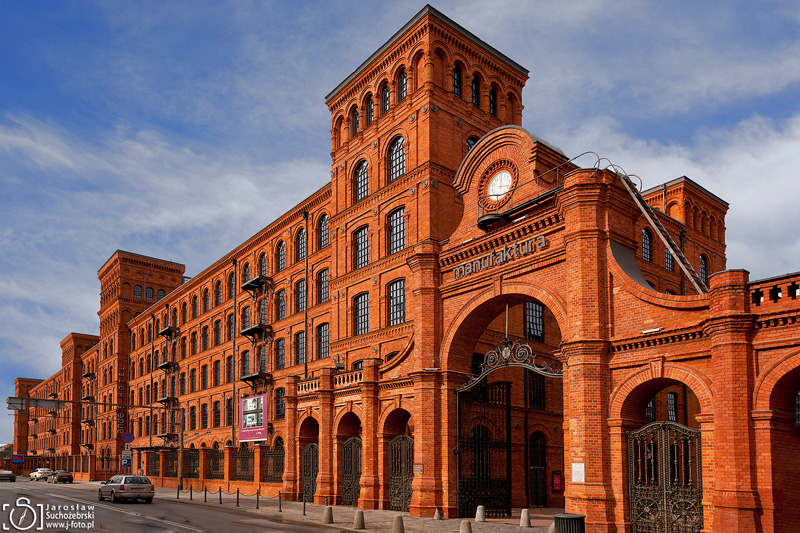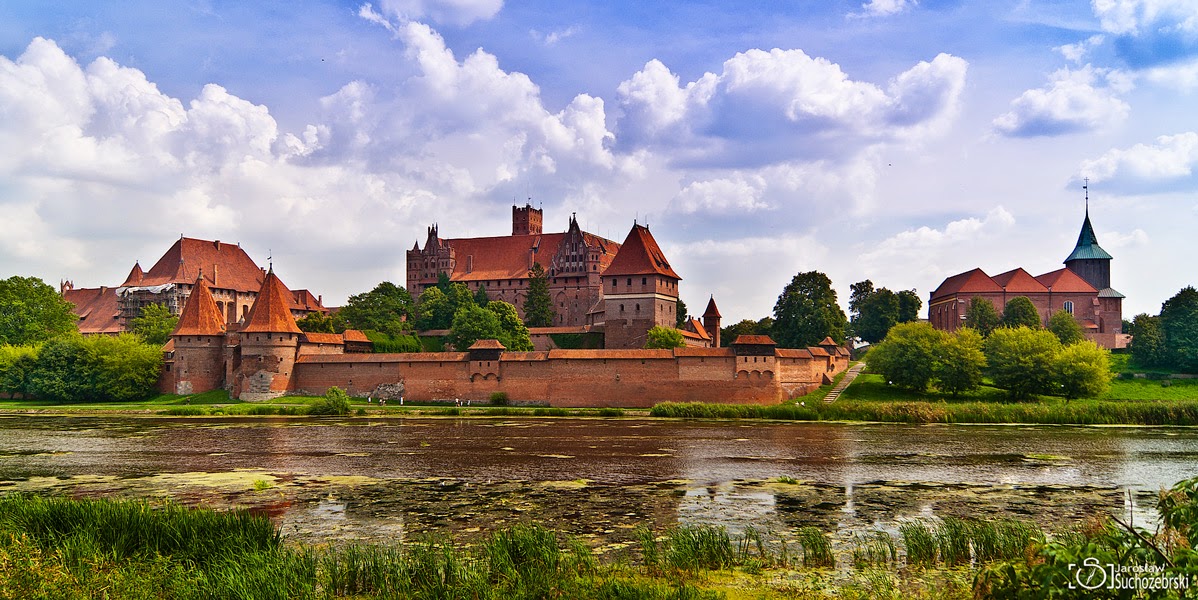 |
| Spinning mill (today hotel) and main gate of former Poznański's factory |
The beginnings of the Poznański textile factory
Izrael K. Poznański was born on 25 August 1833 in Aleksandrów near Łódź, as the youngest son of Kalman Poznański. A year later, the Poznańskis moved to Lódź. In 1851 he married Leonia Hertz, daughter of the clerk of Jewish hospitals in Warsaw. This marriage enriches Izrael Poznański’s, a master of „weaving profession” at the time, fortune by a manufacturer worth 500 roubles.
 |
| Main gate of the former Poznański's factory |
He started to work for Karol Scheibler's company in Łódź. However, he was gradually setting out to accomplish his greatest project - the construction of a great factory. From 1871 Poznański began to buy out the green-licks between Ogrodowa, Stodolniana (now: Zachodnia) and Podrzeczna Streets. The construction of Poznański’s industrial complex began in the 70s of 19th century. The first building was a weaving mill with a saw-tooth roof, the first of its kind in Łódź. In 1872 the factory's first department was set in motion - the weaving mill, equipped with 200 English-made mechanical looms which constituted a technological breakthrough in the textile industry.
 |
| Former building of the factory fire department |
The development of the industrial empire
In the years 1874-1875, he added another 1040 looms to his weaving factory as well as textiles finishing department. The most splendid building is the spinning mill situated along Ogrodowa Street, was built between 1876 and 1878. The impressive building of spinning mill was equipping with 3600 spindles. Symbolic of the whole complex are the monumental gates on Ogrodowa Street, leading into the former factory site.
In 1878 Izrael K. Poznański awarded a bronze medal for the products presented at the Exposition Universelle, the World's Fair in Paris.
 |
| Former building of the Printing, Dye and Finishing Works (now: entertainment centre, cinema and Museum of Factory) and factory power plant (left) |
In the next years, he was open a new threading department and was founded a gas plant for his factory and establishes a fire department for his factory. At the end of 19th century, he builds the so-called tall weaving works and the tall warehouse in the west end of the factory complex.
 |
| Former Low Weaving Mill (now restaurants and bars) |
In the early 20th century the Poznańskis' factory produced million of metres of cotton material. The industrial empire of Poznanski was a self-sufficient district which included the owner's residence, factory, workers housing complex, church and a hospital (read more at:
Poznański Palace in Łódź - impressive 19th-century manufacturer's residence). Apart from his expanding business Izrael K. Poznański owned numerous land allotments and real properties.
 |
| The Manufaktura market square |
Izrael K. Poznanski was a leader of the Jewish Commune in Łódź and also a great philanthropist. He donated land to establish the Jewish cemetery in Bracka Street, covered the construction costs of a hospital. His financial support helped to build the synagogue and orthodox church.
 |
| Former Counting House |
Izrael K. Poznański died on 29 April 1900 in Łódź. He was buried at the Jewish cemetery in Bracka Street in Łódź (read more at:
Jewish Cemetery in Łódź, Poland).
The collapse of the industrial empire and the creation of Manufaktura
The rapid industrialisation of Łódź and its cruel effects on workers was described at the beginning of 20th century by Polish writer and Nobel Prize laureate, Władysław Reymont in the novel "Ziemia obiecana" (The Promised Land). The screen adaptation of Reymont's novel was released in 1974 by Andrzej Wajda, famous Polish movie director and is considered one of his best films. The movie was filmed among others, in the former industrial empire of Izrael Poznański.
 |
| Poster in the Museum of Factory |
After the death of Izrael Poznański, the business was run by his family. After the death of Izrael Poznański, the business was run by his family. The company opened its own railroad station and new power plant. Before Word War I in the factory were working over 7000 people. Unfortunately, the outbreak of World War I caused the financial problems of the company. After the Word War II, the communists were assumed power in Poland and all factories in Poland was nationalised. In the 80s the business lost its financial stability and the factory was closed.
 |
| Image of factory complex from the end of 19th century in the old securities of ”I. K. Poznański” - Joint Stock Society of Cotton Products |
At the end of the 90s, it was a former factory complex was sold and new owners start the renovation process. In 2006 it was opened there Manufaktura - the centre of entertainment, culture and commerce. There are over 300 stores, malls, restaurants, pastry shops, cafes, pubs and other services located mostly in the renovated buildings of former Poznański's factory.
 |
| Symbol of "Manufaktura" in front of former Bleachery mill |
In one of the former factory building is located The Museum of the Factory. The museum offers you a possibility to learn the history of textile factory founded by Izrael Poznański in mid 19th century. You can get to know also the way of cotton from the plantation, through the factory in order to become a beautiful fabric.
 |
| Spinning machines in the Museum of Factory |
You can also visit the
impressive palace of Izrael Poznański, which is the largest manufacturer's residence in Poland. It is also worth visiting the "ms² – Museum of Art", with its impressive collection of modern art.
In 2015 a Spinning Mill and Factory Gate were considered as Historic Monuments.
 |
| Spinning machines in the Museum of Factory |
 |
| The Manufaktura market square |
You can also read other articles about Łódź:
* * *
Outdoor Wednesday, Photo Friday, Skywatch Friday, Weekend Travel Inspiration






































such a beautiful building. fantastic pictures-
ReplyDeleteI find that industry really fascinating, it's good it's been well kept and looked after for history purposes.
ReplyDeleteYes--- Beautiful building, wonderful idea. Thanks for sharing this.
ReplyDeleteJedno z miejsc które najbardziej chciałabym zwiedzić... Cudowna architektura
ReplyDeleteVery interesting history and I really like the photograph of the looms.
ReplyDeleteWhat a beautiful brick building.
ReplyDeleteMy ABC WEDNESDAY
IMPRESSIVE INDUSTRIAL building
ReplyDeleteROG, ABCW
Beautiful shots of the place. The architecture is amazing.
ReplyDeletePretty red brickwork and interesting history. What a luck, that they have restored the buildings, with us in Germany they only destroy all...
ReplyDeleteWill get the nouvel and read it.
Greetings from Germany
Beautiful historical shots.
ReplyDeleteThe bricks are so uniform and red!
ReplyDeleteImpressive place to visit but that brick does stand out and hit you in the face
ReplyDeleteIf only we still built factories that look like that! That was a really interesting read - what an impressive accolade to win bronze medal at the Exposition Universelle.
ReplyDeleteFascinating post. Great photo tour.
ReplyDeleteGorgeous building and fascinating photos!
ReplyDeleteWhat a beautiful building! And rich in history as well...Great snaps :)
ReplyDeleteAmazing place!!!
ReplyDeleteI enjoyed reading the history of this awesome building. It really is impressive and Izarel did some wonderful things for the people & community. Thanks for sharing this wonderful photo essay! Thanks for joining me for WW!
ReplyDeletebeautiful all over... the historie, the photo's, the color so bright... amazing!
ReplyDeleteHave a nice ABC-day / -week
♫ M e l ☺ d y ♫ (abc-w-team)
http://melodymusic.nl/20-i/
Fantastic building and its color too!
ReplyDeletealgunas fotos parecen pinturas! fantástico!!
ReplyDeleteThis reminds me so much of Manchester!
ReplyDeleteWow it's all so picture perfect. I love the look of brick building #wanderfulwednesday
ReplyDeleteit's really stood the test of time! Beautiful building :)
ReplyDeleteI love the red bricks, it reminds me of a few places in the UK. Such a beautiful, beautiful building!
ReplyDeleteLOVE the architecture and colour of the bricks. What a wonderful history your country has too.
ReplyDeleteLeslie
abcw team
What a stunning building, so glad they restored it and still use it today, rather than demolish it! #citytripping
ReplyDeleteWhat incredible history! I also love the red bricks of the building! Gorgeous photos :D
ReplyDeleteBeautiful photographs and interesting history.
ReplyDeleteThanks for another in your series of the industrial revolution/textile industry in Lodz. The red brick buildings are stunning. I'm happy that the buildings were re-purposed in Manufaktura and that they maintained a museum to show heritage.
ReplyDeleteNice captures
ReplyDeleteGreat pictures
ReplyDeleteWow, the contrast between the buildings and the sky is startling! I love that they've kept it as a museum as well. That market square is gorgeous.
ReplyDeleteLove the contrast of blue sky and architecture!
ReplyDeleteVery beautiful photos. Love it.
ReplyDeletea factory? Looks more like a castle. Very impressive. :)
ReplyDeleteVery interesting! Thanks for sharing!
ReplyDeleteYou share the most interesting photos and stories. Thank you so much for linking up with Friday Foto Friends!
ReplyDeleteSuch beautiful photos that capture another time in history!
ReplyDeleteBeautiful red buildings !
ReplyDeleteSome gorgeous shots and a fascinating history. Thanks for sharing this :-)
ReplyDeletebeautiful building and I'm glad that it's repurposed to restaurants and stores and it wasn't left abandoned!
ReplyDeleteMajestic building, beautifully captured.
ReplyDeleteImpressive place! Glad it's been kept up.
ReplyDeleteWhat an impressive building - glad it is still being used today and interesting to trace the changes of 19th and 20th century history through one man and his factory and legacy. Thanks for linking up with #citytripping
ReplyDeleteWhen in Poland, I had been told that Łódź was an unattractive, industrial city. However, you've just shown me that it can be quite attractive because of it's industrial past. It reminds me a little of Stary Browar in Poznan actually. #wanderfulwednesday
ReplyDeleteGreat photographs and insight into the industrial history of Lodz. #citytripping
ReplyDeleteThis is a fascinating site. I'd love to visit someday. Thanks for linking in this week at #wkendtravelinspiration!
ReplyDeleteThank you for sharing such an interesting place. The structures are just amazing with wonderful doors and your photos are just lovely. They so tell the story....
ReplyDeleteYou take excellent photos! So sharp and clear colors! You have an interesting photo site!
ReplyDelete